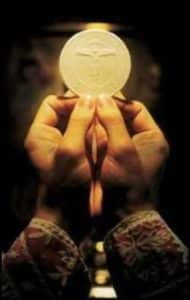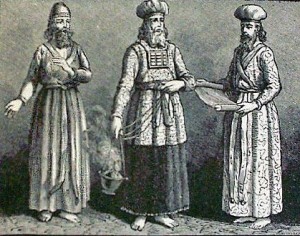The position of priesthood in the church has been evident since the earliest existence of the church. Jewish priests first were established in the seventh century BC performing religious ceremonies. They were even more established around 950 BC due to the establishment of the Temple in Jerusalem.
The major role of the traditional Jewish priest was to perform sacrificial rituals. According to the Bible, the Temple was built as a  place for God to live with the people. It was the holiest building that existed, and needed to be kept holy by the priests. Their role of the priests was to perform animal sacrifices to God as an offering.
place for God to live with the people. It was the holiest building that existed, and needed to be kept holy by the priests. Their role of the priests was to perform animal sacrifices to God as an offering.
The priests performed these sacrifices as specialists on behalf of a community or congregation in order to restore the holiness of the community and of the Temple. It was believed that if there was sin among the people then God would not come and be with them. After the Temple was destroyed during the war with Rome, these animal sacrifices were stopped, and there were no more active Jewish priests. The religious leadership in the synagogue was led by the rabbis. In the Protestant religion there exists a “priesthood of all believers”(“Priesthood”, 529). This meant that each member in the community serves as his or her own priest, with direct access to communication with God. Protestants believe that the role of the priest is an “officiating mediary”(“Priesthood”, 529), rather than a one who performs ritual sacrifices. This stems from the Protestant belief that Jesus Christ served as “the ultimate” sacrifice, and therefore there is no use in animal sacrifices. Protestants also do not call their religious leaders “priests” because the name itself implies that he is of a higher level than his fellow man or that he has more access to God than others.
There exist two different forms of priesthood: hereditary and vocational priests. A hereditary priest is a limited position in that it can only be held by a person who a direct descendent of the tribe of Levi. This tribe is one of the original 12 tribes of Israel as set forth in Genesis 49. There exists among this tribe one High Priest who head of the other priests. He is the only priest who was allowed to view the Holy Ark of the Covenant during the existence of the Temple in Jerusalem. These hereditary priests, unlike most priests in today’s society, were allowed to marry in order to carry on the line of priesthood. The vocational priests are those which have been “called” to the ministry by God himself. A “calling” is an “impulse by God that attracts certain persons to a life of ministry”(“Calling”, 176). This area of priesthood is beneficial in that it has the “potential advantage of selectivity for devotional, intellectual, or moral qualities”(“Priesthood”, 530).
The problem with hereditary priests was that there often existed priests which were not very holy men, but they were given the  position due to their family name. Vocational priests are only men who became priests because they felt that what God wanted them to do. There are certain requirements which must be kept by priests in order for them to be able to continue doing the work of God. One of these requirements is that he is of sound mind. “Apart from practical reasons of community leadership, this requirement is frequently supported by a notion of perfection as appropriate to the sacrificial ritual. Just as a sacrificial animal is expected to be whole and without blemish, so should the sacrificer himself be. Traditional Roman Catholic custom has required in particular that the hands of a priest, which perform the sacrament, be without deformity”(“Priesthood”, 530) The tradition of celibacy is something that may be required, as the Roman Catholic church does, but it is not required by all denominations with priests.
position due to their family name. Vocational priests are only men who became priests because they felt that what God wanted them to do. There are certain requirements which must be kept by priests in order for them to be able to continue doing the work of God. One of these requirements is that he is of sound mind. “Apart from practical reasons of community leadership, this requirement is frequently supported by a notion of perfection as appropriate to the sacrificial ritual. Just as a sacrificial animal is expected to be whole and without blemish, so should the sacrificer himself be. Traditional Roman Catholic custom has required in particular that the hands of a priest, which perform the sacrament, be without deformity”(“Priesthood”, 530) The tradition of celibacy is something that may be required, as the Roman Catholic church does, but it is not required by all denominations with priests.
Some other interesting requirements of a priest is that he be a good speaker and good and pronunciation. This is essential for the prayers of the priest. Priests which were required to do animal needed to be trained as a veterinary surgeon. Lastly, priests must also have background in theology and history in order to also minister to the intellectual life of their congregation. As you can see there are many aspects of priesthood. They provided the church with the proper leadership and knowledge which is needed to be able to serve God in the proper manner. They have been prevalent throughout religious history and they will surely continue to play a major role in modern religion today and in the future.
